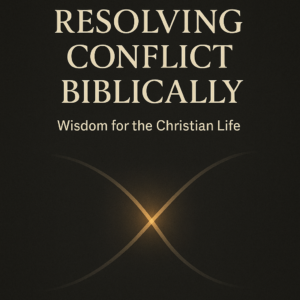⏱️ Estimated Reading Time: 7 min read
When we look to Jesus and behold Him in all His glory with spiritual eyes of faith, we see and learn who God truly is. This is because, as Paul, in Colossians 1:15, says, “He is the image of the invisible God, the firstborn of all creation.” As the incarnate Logos, Jesus reveals to us both the nature of God and the power and wisdom of God (1 Cor. 1:24). In Him, the fullness of the Triune God dwells in bodily form (Col. 1:19).
This, in itself, is amazing. Jesus, as the glorious and eternal begotten Son of the Father, full of grace and truth (John 1:14), reveals to us who our Triune God truly is. As King of kings and Lord of lords, we see His divine rulership. As judge, we see His holiness and justice. And as Savior, we see His mercy, love, and grace.
But, just as wonderful, is the truth that we now abide in Christ by faith, and He abides in us (John 6:56). By faith, we feed on Christ’s flesh and drink His blood, actually participating in His sufferings. God counts it as though we were crucified with Christ, buried with Him, and resurrected with Him (Rom. 6:1-4).
As Paul puts it in Galatians 2:20: “I have been crucified with Christ. It is no longer I who live, but Christ who lives in me. And the life I now live in the flesh I live by faith in the Son of God, who loved me and gave himself for me.” Just as we participate in His sufferings, we participate in His life. Indeed, eternal life is presently ours in Christ, even as we await the fullness of that life to come.
It is in the hope of future fullness of life that our attention is drawn. As Paul puts it in 1 Corinthians 13:12, “For now, we see in a mirror dimly, but then face to face. Now I know in part; then I shall know fully, even as I have been fully known.” Or, as John puts it in 1 John 3:2, “Beloved, we are God’s children now, and what we will be has not yet appeared; but we know that when he appears we shall be like him because we shall see him as he is.” The idea here is that being justified by the blood of Christ, we are also positionally sanctified (counted as holy) because we are found to be in Christ. We are, indeed, children of God. But there is a greater transformation yet to take place, where we will be made like Christ. Currently, then, we are progressively being sanctified (being made holy), day by day, being conformed into the image of Christ (Rom. 8:29).
Though this can be described in a multitude of ways, it is helpful to consider progressive sanctification or being daily conformed into Christ’s image in terms of becoming the archetype.
In Plato’s thought, there are archetypes to which all other matter corresponds. The idea was that there were “eidos,” or ideas, that were imprinted on the soul before birth. Thus, in Plato’s thought, the reason why a person could view a horse as a horse and not as an ostrich, for example, was because there was a perfect archetype to which all other horses corresponded. The perfect archetype didn’t need to physically exist; it could merely be a myth. The point was that all other things corresponded to that archetype.
Carl Jung, a psychologist, and collaborator with Sigmund Freud, also played with the idea of archetype in his own psychological thoughts. He believed in a sort of collective unconscious, wherein, imprinted upon every person across time and culture, there were themes and ideas that continually resonate with people and seemingly reoccur across dreams, myths, and visions.
Neither man was Christian by any means (though, likely, many Christians would find more agreement in Plato’s thought than Jung’s), but both bring ideas to the table worth pondering. The idea of an archetype has also made its way into the realm of literature. For example, Hercules may be considered the archetypal hero; he is strong, brave, and possesses the wit to outsmart and out-maneuver his enemies.
The question is, following the principle of common grace (i.e., God had revealed Himself to a creation which suppresses the truth, viz a viz, Romans 1 and the exchanging of worshiping the Creator for the creation), is there any truth from either of these thinkers that can be applied within a Christian paradigm? This is not paganizing Christianity. Rather, as J.R.R. Tolkien explained in his body of works, sanctifying myth by purging all of its pagan elements and stripping it down to whatever core truths may be found within. Pagan myths and thought can be dangerous; therefore, one must search for the truth and beauty within and purge it of its wickedness to sanctify it.
It seems helpful, then, to sanctify the myth of “archetype” by viewing the idea of an “archetype” as finding its greatest fulfillment in Christ, who is, in fact, both the revelation of God and perfect image of what true humanity is supposed to be. It is to the image of Christ, the archetype, to which the Christian life is now to correspond. This is best understood within the paradigm of the already/not yet. The Christian is already saved by Christ, but not yet glorified; already spiritually resurrected, but not yet physically resurrected; already sanctified by the finished work of Christ, but not yet perfect or without sin. Martin Luther called this the, “Simul Justus et Peccator,” or “Simultaneously just and sinner.” In other words, the Christian is not yet completely what he should be, already in Christ, but still becoming like the archetype.
An archetype, in this case, is the most perfect form of something. So, for example, all of the horses in existence are modeled after the archetypal horse. The archetypal horse is the perfect horse. It does not truly need to exist, except for in the mind of God, and, therefore, it can be a myth. All other horses may be modeled after the archetype, but the archetype does not need to exist outside this mythical state.
However, when one looks to Jesus, we see the archetype of perfection all around. He is the archetypal man: He is perfect, sinless, and spotless. He is pure, devoted to the Word and Law of God, and always operative within the Father’s Will. He is not only the perfect man; he is the true man, demonstrating what humanity is supposed to be.
Thus, in Christ, we have a living archetype. He is not merely existent in the mind of God; He is God, who incarnates in the form of flesh. Thus, we have in Christ both a sanctified myth and a myth-making reality. This does not mean that Jesus is mythical; rather, He is archetypal and the only true archetype to ever walk the earth. More than just being a type and shadow, He is the perfect being to which all other types and shadows correspond.
Through the act of salvation, the Christian is made one with Christ, being grafted into His Body. It is rightfully said that the Christian abides in Christ and Christ abides in him. The hope of glory and the life of God resides in the soul of man. Likewise, the Christian participates in Christ’s sufferings in the act of faith.
To reiterate, to believe in Christ by faith is to eat His flesh and drink His blood. This participation in Christ’s body is described by Paul in Galatians 2:20. By faith, we are crucified with Christ, buried with Christ, and risen with Christ.
Yet, though we now enjoy eternal life in Christ, what we shall be finally is not yet revealed. We have not become; we are still becoming. But Jesus is the I AM. Therefore, we are being molded, shaped, and made into Christ’s image. In many respects, though we will never be exactly like Christ, we are becoming the archetype.



